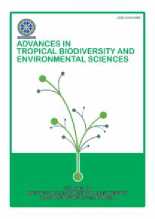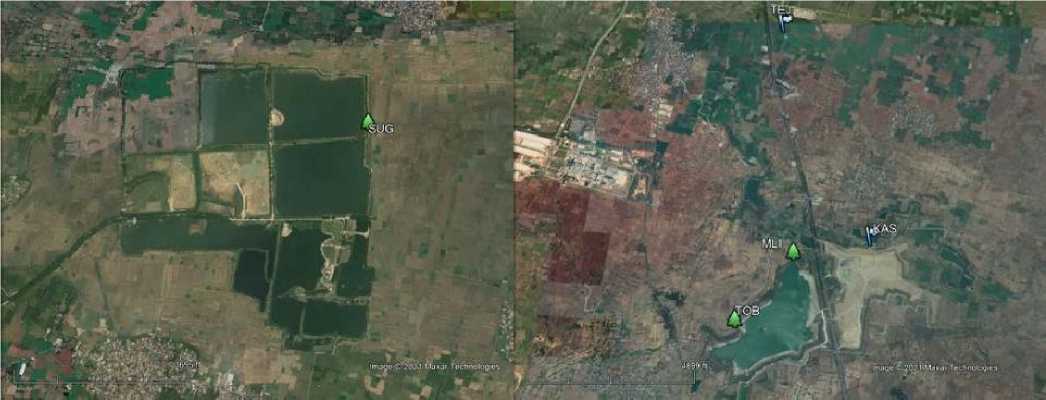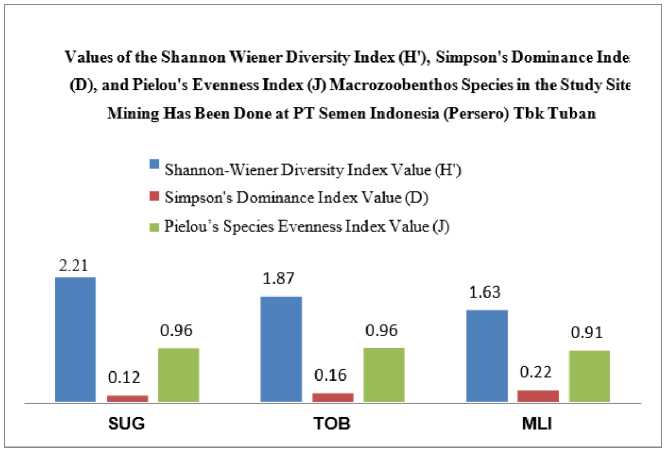Identification and Analysis of Macrozoobenthos in The Reclamation Land Area of Lime Mining
on

Advances in Tropical Biodiversity and
Environmental Sciences
6(2): 45-49, June 2022
e-ISSN:2622-0628
DOI: 10.24843/ATBES.v06.i02.p03
Available online at: https://ojs.unud.ac.id/index.php/ATBES/article/view/87827
Identification and Analysis of Macrozoobenthos in The Reclamation Land Area of Lime Mining
Supiana Dian Nurtjahyani1*, Dwi Oktafitria2, Ahmad Zaenal Arifin2, Sriwulan2, Achmad Yogi Pambudi3, Eko Purnomo4
-
1Department of Biology Education, Postgraduate, University of PGRI Ronggolawe
Jl. Manunggal, Tuban, East Java, Indonesia
-
2Faculty of Mathematics and Science, University of PGRI Ronggolawe
Jl. Manunggal, Tuban, East Java, Indonesia 3Department of Biology Education, Faculty of Teaching and Education Science, University of PGRI Ronggolawe
Jl. Manunggal, Tuban, East Java, Indonesia 4PT. Semen Indonesia (Persero) Tbk *Corresponding author: diananin39@gmail.com
Abstract. Mining activities that occur at PT Semen Indonesia (Persero) Tbk. caused the land to become critical land where the nutrients are low and the ecosystem is disturbed, therefore it is necessary to carry out restoration activities for ex-mining land as an effort to be made for the process of recovering ex-mining land as happened to PT Semen Indonesia Tbk, namely by carrying out reclamation activities. Reclamation is an activity that aims to improve or manage the use of disturbed land due to general mining business activities, so that it can function and be efficient in accordance with its designation. This study aimed to analyze the structure of the macrozoobentos community in the reclamation land ecosystem of PT Semen Indonesia limestone mining. This expected to provide information on the structure of the ecosystem macrozoobentos community on reclaimed land. Sampling of macrozoobentos was carried out in the Sugihan village (SUG) and Mliwang village (MLI), Merakurak district,Tuban regency using the direct hand collecting method. The results of this study indicated that the macrozoobenthos species found on the reclamation land of PT. Semen Indonesia Tbk showed it was included in the medium category.
Keywords: Identification; Macrozoobenthos; Reclamation Land Area
-
I. INTRODUCTION
This PT Semen Indonesia (Persero) Tbk. was a strategic holding company that covers subsidiaries in the field of cement, non-cement and service producers throughout Indonesia. As a State-Owned Enterprise (BUMN), the share portion of PT Semen Indonesia (Persero) Tbk. currently, 51.01% belongs to the Government of Indonesia and 48.99% belongs to the public. Mastering the national market share and regional market reach, the Company strives to become a leading provider of building material solutions in the region by providing a variety of complete and quality products and services.
Law No. 4 of 2009 concerning Mining requires mining companies to carry out reclamation and post-mining repair
activities on the mining area they are working on [1]. The applicable regulations are based on KEPMEN 1211K of 1995 concerning the prevention and control of environmental destruction and pollution in general mining business activities and PERMEN ESDM No. 18 of 2008 concerning reclamation and mine closure. Reclamation of ex-mining land consists of two activities, namely: restoration of ex-mining land to improve ecologically disturbed land and preparing ecologically repaired exmining land for further use [2].
Mining activities that occur at PT Semen Indonesia (Persero) Tbk. can cause the land to become critical land where the nutrients are low, the pH and temperature of the soil are increased and the soil structure was compacted.
become one of the obstacles to the conversion of post-lime mining land into productive land. To improve land that has been mined, it is necessary to carry out restoration activities of ex-mining land. Efforts that can be made as an effort to restore ex-mining land are reclamation activities. Reclamation is an activity that aims to improve or manage the use of disturbed land due to general mining business activities, so that it can function and be efficient in accordance with its designation [3]. Reclamation itself is an activity that cannot be separated from mining activities so that the preservation of the mining environment was maintained.
Macrozoobenthos are organisms that live permanently, and have special adaptability to environmental conditions [4], stated that macrozoobenthos have an important role in food webs. The larval phase of the macrozoobenthos provides a food source for higher estuarine organisms. The community structure of macrozobenthos (mollusks), especially gastropods and bivalves, can provide an overview of important values and have a role in the ecosystem [5].
Several existing studies, such as Zainuri et al., (2012), Hartati et al., (2012) and Putri et al., (2018) use macrozoobenthos as an indicator of water quality which aims to determine the structure of the macrozoobenthos community at that location [6,7,8]. Research conducted by Zainuri et al., (2012) observed molluscs, annelids, and crustaceans in Sayung, Demak.
Mining activities of PT. Semen Indonesia (Persero) Tbk. using an open-pit mining system (surface mining) with the quarry mining method. These activities consist of unloading, loading, and transporting which causes disturbance to the environment which can cause the land to become critical land where the nutrients are low, the pH and temperature of the soil are increased and the soil structure is compacted. this is one of the obstacles to the conversion of post-lime mining land into productive land. Therefore, this study was conducted with the aim of analyzing the structure of the macrozoobenthos community in the limestone mining reclamation land ecosystem of PT Semen Indonesia. This is expected to provide information regarding the structure of the ecosystem macrozoobenthos community on the reclamation land, so that it can be used as a consideration in an effort to increase the knowledge of the ecological biota on the mining land of PT. Semen Indonesia TBK Tuban.
-
II. RESEARCH METHOD
Sampling of macrozoobenthos was carried out in the Sugihan (SUG) and Mliwang (MLI) areas by direct hand collecting method and with the help of a scoop net which was swept on the edge of the water body, especially in vegetated areas. The target specimens in this sampling include larvae of insects, crustaceans, small molluscs and other invertebrates. The research locations are limestone and clay areas as shown in Figure 1.

Figure 1. Location area research lime stone and clay
The samples obtained were sheathed using a sieve to separate the samples obtained from other materials. The smallest mesh size commonly used 0.5 [9]. The sample placed on a sieve and then flowing water until other material other than objects measuring over 0.5 mm will be retained.
Macrozoobenthos retained in each filter were then sorted and identified to taxa genus or species. Identification of macrozoobenthos species based on Carpenter & Niem (Ed.) (1998), Djajasasmita (1999) and Dharma (2005) as well as other representative literature [10,11,12].
One approach that was often used to determine the condition of the macrozoobenthos community is an approach based on the Shannon-Wiener diversity index (H'), Simpson dominance index (D) and Pielou evenness index (J).
H’ = -∑ (N) log (N)
Description:
H’: Indeks Diversitas Shannon-Wienner
Pi: Proportion of abundance for each species ni: Number of individuals of type i
N: Total number of individuals
Diversity Index value, the quality of a water can be known based on the water quality table based on the macrozoobenthos diversity index [13]. The ShannonWiener formulation and water quality table based on the diversity index used for macrozoobenthos are the same as the formulation and index for plankton biota. In addition to the three indices, this study uses the Family Biotic Index, which is often used for macrozoobenthos communities in freshwater. This index based on the ability of macrozoobenthos tolerance to exposure to organic pollutants. The tolerance value ranges from 0 – 10, the value of which increases for each family of macrozoobenthos along with the decrease in the quality of the water it inhabits. This value was developed by Hilsenhoff (1988) to show variations in macrozoobenthos tolerance which was then used to calculate the Modified Family Biotic Index to detect the level of organic pollution in the observed waters [14].
The Family Biotic Index (FBI) can be searched based on the following formulation:
FBI =
τι1xt1
N
Description:
ni: Number of macrozoobenthos individuals
ti: Tolerance value for each family of macrozoobenthos
N: Total number of collected macrozoobenthos
The basic water quality assessment using the FBI Index showed in Table I.
TABLE I
WATER QUALITY ASSESSMENT WITH FBI INDEX
|
Famili Biotic Index |
Water Quality |
Pollution level |
|
0.00 – 3.75 |
Very very good |
Not Polluted |
|
3.76 – 4.25 |
Very good |
possibility of Polluted |
|
4.26 – 5.00 |
Good |
Slightly polluted |
|
5.01 – 5.75 |
Medium |
Medium polluted |
|
5.76 – 6.50 |
Rather Bad |
quite heavily polluted |
|
6.51 – 7.25 |
Bad |
heavily polluted |
|
7.26 – 10.00 |
Very Bad |
heavily polluted |
-
IV. RESULT AND DISCUSSION
Abundance of Macrozoobenthos
Based on the results of the study, it was showed 10 macrozoobenthos species consisting of 7 species of the class Gastropods, 2 species of members of the class Crustacea and 1 species of Insecta larvae. The composition and abundance of the highest macrozoobenthos species was at the SUG location which was possible because it had the complexity of community members that synergized with the environment. This is different from the TOB and MLI areas which tend to be natural so that the ecological process runs naturally (tends to be slower). The low abundance of macrozoobenthos in the TOB and MLI areas can also be caused by the difficulty in sampling because the topography of the embankment slopes tends to be steep. The composition of macrozoobenthos in the three clay mining areas.
It has been mentioned that members of the macrozoobenthos community of freshwater gastropod species are abundant, for example Melanoides tuberculata, Bellamya javanica, Pomacea canaliculata, Lymnaea rubiginosa and Tarebia granifera. These gastropods generally act as grazers, which means they feed on biofilm and/or algae attached to the substrate surface. The substrate at the bottom of the muddy waters with a lot of litter causes the study location to become a habitat for grazer molluscs and crustaceans that eat litter (shredder) and other organic materials. The existence of riparian and submerged vegetation on the banks of the reservoir makes the SUG, TOB, MLI areas suitable for various insect species, especially those that require water (or live in water) in one of their life cycles, for example dragonfly larvae (Odonata) from the family Libellulidae (eg Dragonfly orange wing or Brachythemis contaminata and Coenagrionidae (cozy needle-dragonfly). According to Rahayu (2015), several other factors that influence the high abundance of macrozoobenthos are differences in the availability of food ingredients, as well as human activities in each waters [15]. However, it was also mentioned that the abundance of macrozoobenthos was also influenced by the level of adaptation, competition and predatorism. Gastropods are a group of animals from the phylum molluscs that live in the type of substrate from coarse to fine. Gastropod abundance is influenced by physical factors in the waters and one of them is TSS (Total Suspended Solid) TSS is suspended solids consisting of silt and fine sand and microorganisms, which are mainly caused by soil friction or soil erosion that has been dragged into bodies of water in the water [16]. Several other factors that affect the high abundance of macrozoobenthos are differences in the availability of food ingredients, as well as human activities in each waters. However, it is also
mentioned that the abundance of macrozoobenthos is also influenced by the level of adaptation, competition and predatorism, states that the basic substrate or soil texture is a very important component for the life of organisms. The bottom substrate of the waters will determine the abundance and composition of macrobenthos animal species. [17]
Community Structure
The value of the diversity index (H') of macrozoobenthos obtained from the January-June 2021 period is at SUG of 2.21; TOB of 1.87; and MLI of 1.63. The index value of macrozoobenthos diversity in all areas is 1.00 <H'<3.00 so it is included in the category of moderate diversity. This shows that environmental factors have an influence on the life of macrozoobenthos organisms. The value of the Simpson dominance index (D) is also known to be close to the value of 0.00 (zero), indicating that there are no dominating taxa, therefore species diversity in the community is quite high.
The evenness index (J) showed in the location of SUG of 0.96; TOB of 0.96; and MLI of 0.91 (Figure 2). The value of J which is close to 1.00 (one) indicates that the
environmental conditions are normal which is characterized by the distribution of the population which tends to be even and there is no dominance among macrozoobenthos species. Based on the FBI (Family Biotic Index) assessment of macrozoobenthos of 5.85, indicating that the water quality is in the "moderate" category with a "medium polluted" level of pollution. However, the condition of the waters is relatively stable with a diverse composition of macrozoobenthos, the moderate level of pollution that occurs in the location is possible due to the presence of high organic matter but is still able to be remedied by nature naturally. So in general it can be said that there is no disturbance of the macrozoobenthos community in the mining area. clay mining [Sugihan (SUG); Tobo (TOB); Mliwang (MLI)] for the clearing and clearing of land that has been carried out by the company. According to Ernanto (2010), a community is said to have high diversity if it is composed of several species with the same or almost the same species abundance. However, if the opposite occurs, it can be said that the diversity is low. Referring to the research, it can be said that the average of the four stations is in the medium category [18].

Figure 2. Graph of the Shannon Wiener Diversity Index (H'), Simpson's Dominance Index (D), and Pielou Evenness Index (J) of Macrozoobenthos Species in the Study Site Mining Has Been Done at PT Semen Indonesia (Persero) Tbk Tuban
-
V. CONCLUSION
Identification of macrozoobenthos in The reclaimation land area of liming mining showed 10 species consisting of 7 species of the class Gastropods, 2 species of members of the class Crustacea and 1 species of Insecta/insect larvae. The diversity index value (H') of macrozoobenthos obtained at SUG is 2.21; TOB of 1.87; and MLI is 1.63, so it is worth 1.00<H'<3.00 therefore in the category of medium diversity.
REFERENCES
-
[1] Undang-undang Republik Indonesia Nomor 4 Tahun 2009. Tentang Pertambangan Mineral Dan Batubara.
-
[2] Latief, MF., P.I. Khaerani, H. Iskandar, J.A. Syamsu, S.Akil. 2019. Tinjauan Reklamasi Lahan Pasca Tambang Timah (Sn) Melalui Penanaman Tumbuhan Pakan. Prosiding Seminar Nasional Membangun Sumber Daya Peternakan di Era Revolusi Industri 4.0. Makassar.
-
[3] Adi, A.N.I.Y.W., S.Widodo., dan A. Nurwaskito. 2017. Analisis Reklamasi Tambang Batukapur di Kecamatan Bungoro Kabupaten Pangkep Provinsi Sulawesi Selatan. Jurnal Geomine, 5(2), 68–75.
-
[4] Ulfah, Y., Widianingsih, Zainuri, M. 2012. Struktur Komunitas Makrozoobenthos di Perairan Wilayah Morosari Desa Bedono Kecamatan Sayung Demak. Journal of Marine Research. 1(2):188-96
-
[5] Isnaningsih, N.R., dan M.P.Patria. 2018. Peran Komunitas Moluska Dalam Mendukung Fungsi Kawasan Mangrove di Tanjung Lesung, Pandeglang, Banten. Biotropika: J of Tropical Biology, 6(2):35-44.
-
[6] Zainuri, M., Yuniar, S.A. & Endrawati, H. 2012. Struktur Komunitas Makrozoobentos di Perairan Morosari, Kecamatan Sayung, Demak. Journal of Marine Research, 1(2):235-242
-
[7] Hartati, R., M.Ulum., dan Widiningsih., 2012. Komposisi Kelimpahan Makrozoobenthos Krustasea di Kawasan Vegetasi Mangrove Kel. Tugurejo, Kec. Tugu, Kota Semarang. Journal of Marine Research, 1(2):243-251
-
[8] Putri, D.C., Suprijanto, J., dan Taufiq-Spj, N. 2018. Struktur Komunitas Krustasea Decapoda pada Ekosistem Mangrove di Kecamatan Genuk Semarang. Journal of Marine Research., 7(1): 1
-
[9] English, S., C. Wilkinson and V. Baker (ed.). 1994. Survey Manual for Tropical Marine Research. Townsville: ASEAN-Australia Marine Science
Project. Australian Institute of Marine Science.
-
[10] Carpenter, K.E., and V.H. Niem. 1998. The living marine resources of the Western Central Pacific. v. 1: Seaweeds, corals, bivalves and gastropods-v. 2:
Cephalopods, crustaceans, holothurians and sharks-v. 3: Batoid fishes, chimaeras and bony fishes, pt. 1 (Elopidae to Linophrynidae)-v. 4: Bony fishes, pt. 2 (Mugilidae to Carangidae).-v. 5: Bony fishes, pt. 3:(Menidae to Pomacentridae).-v. 6: Bony fishes, pt. 4:(Labridae to Latimeriidae), estuarine crocodiles, sea turtles, sea snakes and marine mammals.
-
[11] Dharma, B. 2005. Recent and Fossil Indonesian Shells. Hackenheim: Conchbooks.
-
[12] Djajasasmita, M., S.N.Kartikasari and Januar. Keong dan kerang sawah. Puslitbang Biologi-LIPI.
-
[13] Wibisono, M.S. 2005. Pengantar Ilmu Kelautan. Grasindo-Gramedia Widiasarana Indonesia, Jakarta.
-
[14] Hilsenhoff, W. L. 1988. Rapid field assessment of organic pollution with a family-level biotic index. Journal of the North American benthological society, 7(1), 65-68.
-
[15] Nada, M.S., N.Taufik dan S.Redjeki. 2021. Kondisi Makrozoobentos pada Ekosistem Mangrove, Pulau Pari, Kepulauan seribu, Jakarta. Buletin Oseanografi Marina. Vol. 10. No. 1:33-41
-
[16] Suryanti, A., R.K.Hartoko and Sari. 2017. Relation Analyse of TSS with Abundance of Gastropods Using Landsat Sattelite Imagery in Nongsa Beach Batam. Journal of Biodiversity and Environmental Sciences(JBES). 2(10): 213-219.
-
[17] Odum, E.P. 1993. Dasar Dasar Ekologi, Edisi Ketiga. Tjahjono Pacific. Aquat. Living Resour. 5:107-114
-
[18] Ernanto, E., F. Agustriani dan R. Aryawati. 2010. Struktur Komunitas Gastropoda Mangrove di Muara Sungai Batang Ogan Komering Ilir Sumatera Selatan. Maspari Journal. 1: 73-78.
Discussion and feedback